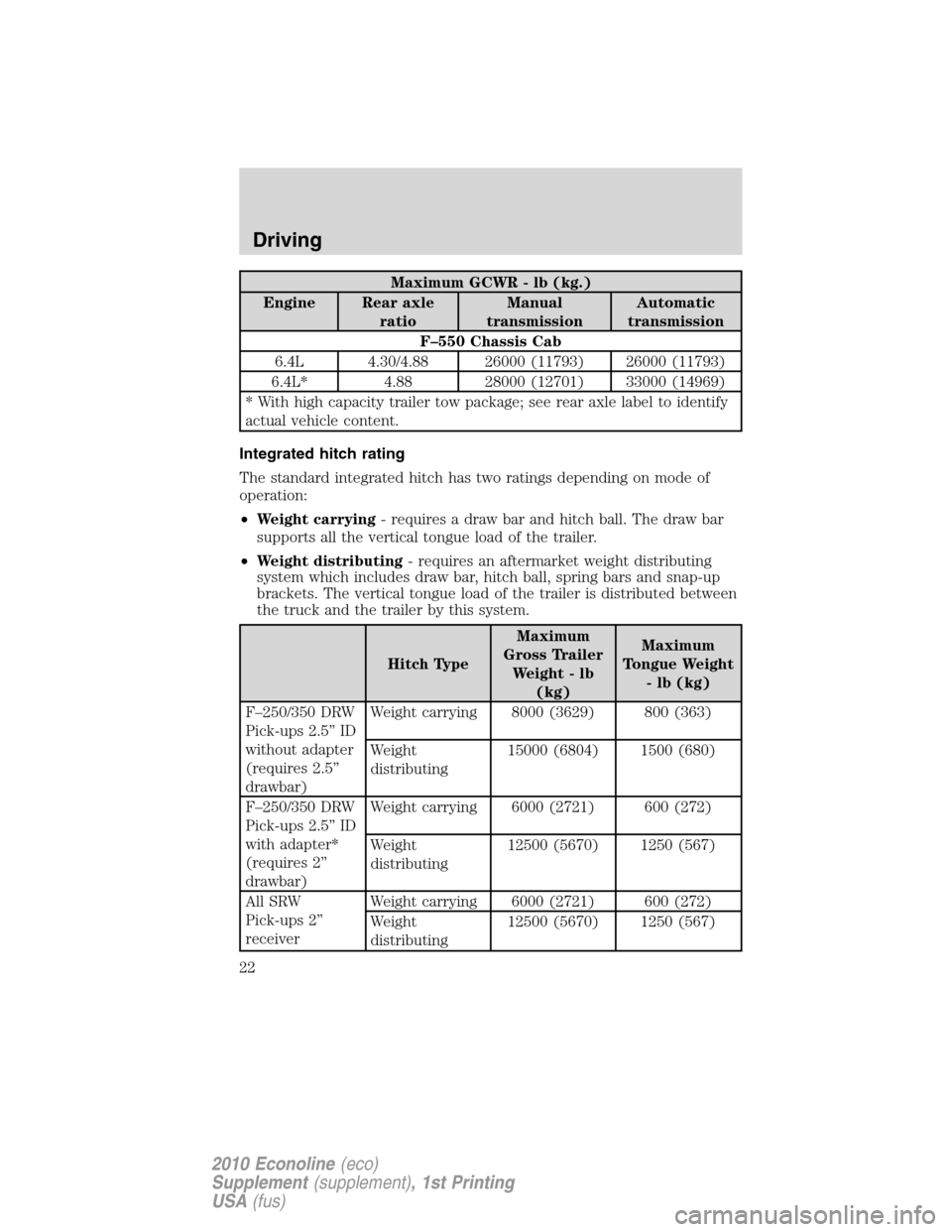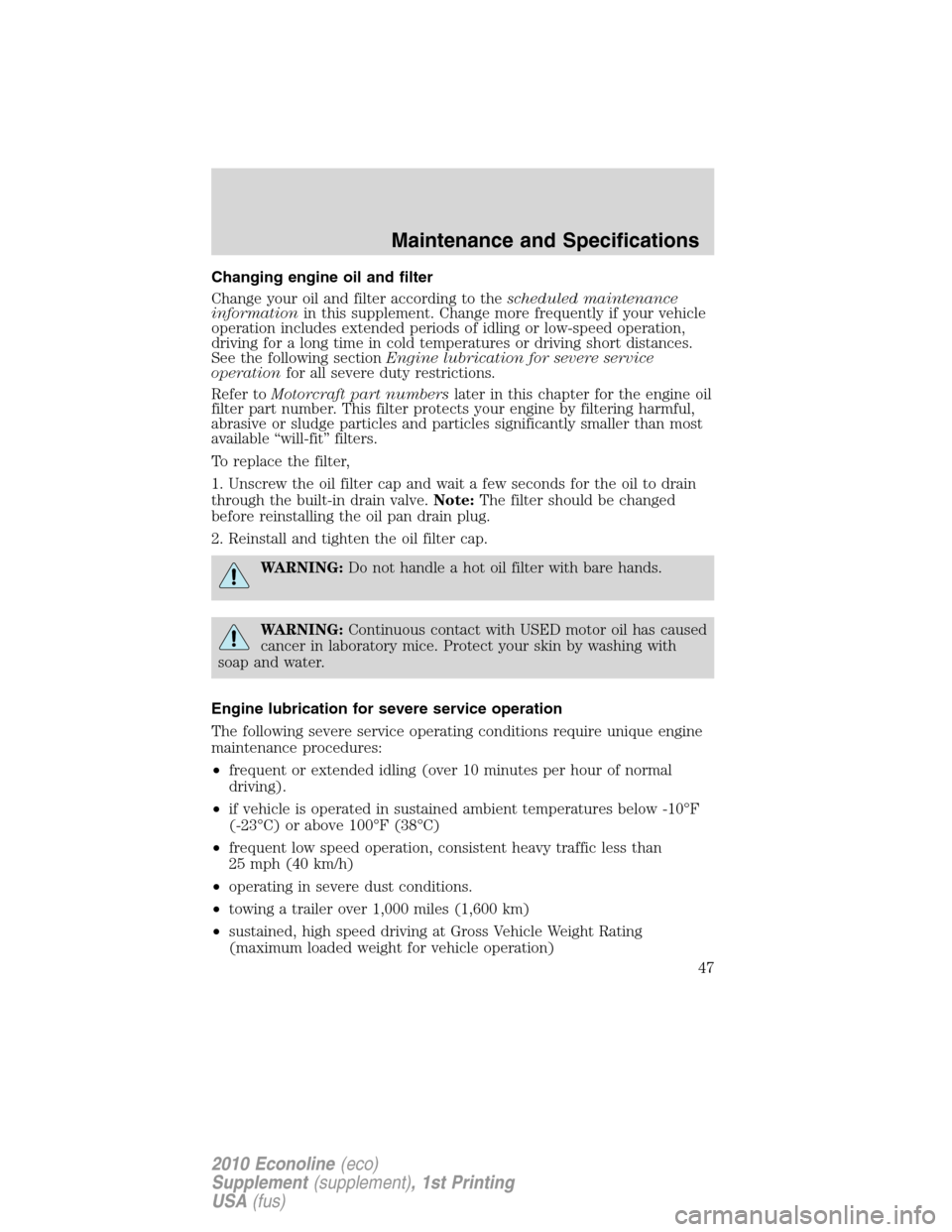Page 22 of 104

Maximum GCWR - lb (kg.)
Engine Rear axle
ratioManual
transmissionAutomatic
transmission
F–550 Chassis Cab
6.4L 4.30/4.88 26000 (11793) 26000 (11793)
6.4L* 4.88 28000 (12701) 33000 (14969)
* With high capacity trailer tow package; see rear axle label to identify
actual vehicle content.
Integrated hitch rating
The standard integrated hitch has two ratings depending on mode of
operation:
•Weight carrying- requires a draw bar and hitch ball. The draw bar
supports all the vertical tongue load of the trailer.
•Weight distributing- requires an aftermarket weight distributing
system which includes draw bar, hitch ball, spring bars and snap-up
brackets. The vertical tongue load of the trailer is distributed between
the truck and the trailer by this system.
Hitch TypeMaximum
Gross Trailer
Weight-lb
(kg)Maximum
Tongue Weight
- lb (kg)
F–250/350 DRW
Pick-ups 2.5” ID
without adapter
(requires 2.5”
drawbar)Weight carrying 8000 (3629) 800 (363)
Weight
distributing15000 (6804) 1500 (680)
F–250/350 DRW
Pick-ups 2.5” ID
with adapter*
(requires 2”
drawbar)Weight carrying 6000 (2721) 600 (272)
Weight
distributing12500 (5670) 1250 (567)
All SRW
Pick-ups 2”
receiverWeight carrying 6000 (2721) 600 (272)
Weight
distributing12500 (5670) 1250 (567)
Driving
22
2010 Econoline(eco)
Supplement(supplement), 1st Printing
USA(fus)
Page 23 of 104
Hitch TypeMaximum
Gross Trailer
Weight-lb
(kg)Maximum
Tongue Weight
- lb (kg)
F–450 DRW
Pick-ups 2.5” ID
without adapter
(requires 2.5”
drawbar)Weight carrying 8000 (3629) 800 (363)
Weight
distributing16000 (7258) 1600 (726)
F–450 DRW
Pick-ups 2.5” ID
with adapter*
(requires 2”
drawbar)Weight carrying 6000 (2721) 600 (272)
Weight
distributing12500 (5670) 1250 (567)
WARNING:Towing trailers beyond the maximum tongue weight
exceeds the limit of the towing system and could result in
vehicle structural damage, loss of vehicle control and personal injury.
* Trailer hitch adapter is available from Ford dealers (Part number:
5C3Z-19H282–A).
Driving
23
2010 Econoline(eco)
Supplement(supplement), 1st Printing
USA(fus)
Page 47 of 104

Changing engine oil and filter
Change your oil and filter according to thescheduled maintenance
informationin this supplement. Change more frequently if your vehicle
operation includes extended periods of idling or low-speed operation,
driving for a long time in cold temperatures or driving short distances.
See the following sectionEngine lubrication for severe service
operationfor all severe duty restrictions.
Refer toMotorcraft part numberslater in this chapter for the engine oil
filter part number. This filter protects your engine by filtering harmful,
abrasive or sludge particles and particles significantly smaller than most
available “will-fit” filters.
To replace the filter,
1. Unscrew the oil filter cap and wait a few seconds for the oil to drain
through the built-in drain valve.Note:The filter should be changed
before reinstalling the oil pan drain plug.
2. Reinstall and tighten the oil filter cap.
WARNING:Do not handle a hot oil filter with bare hands.
WARNING:Continuous contact with USED motor oil has caused
cancer in laboratory mice. Protect your skin by washing with
soap and water.
Engine lubrication for severe service operation
The following severe service operating conditions require unique engine
maintenance procedures:
•frequent or extended idling (over 10 minutes per hour of normal
driving).
•if vehicle is operated in sustained ambient temperatures below -10°F
(-23°C) or above 100°F (38°C)
•frequent low speed operation, consistent heavy traffic less than
25 mph (40 km/h)
•operating in severe dust conditions.
•towing a trailer over 1,000 miles (1,600 km)
•sustained, high speed driving at Gross Vehicle Weight Rating
(maximum loaded weight for vehicle operation)
Maintenance and Specifications
47
2010 Econoline(eco)
Supplement(supplement), 1st Printing
USA(fus)